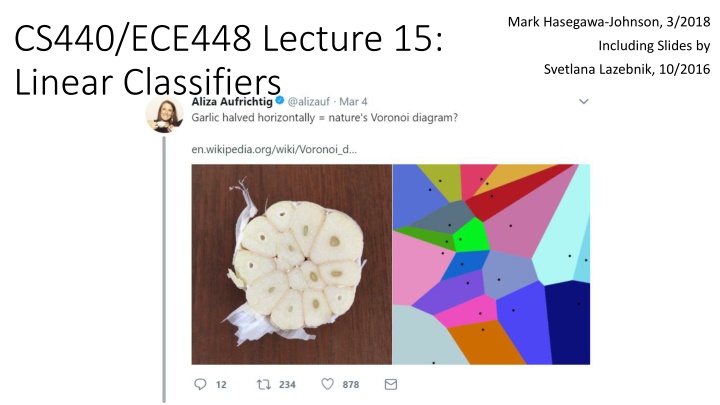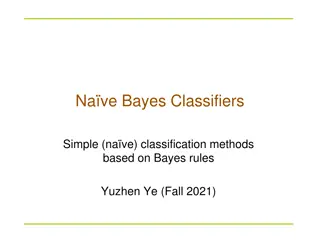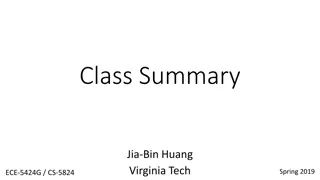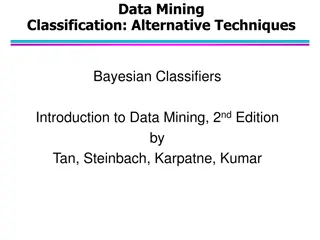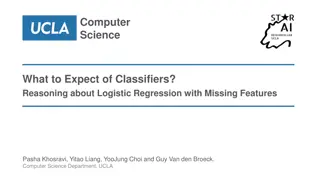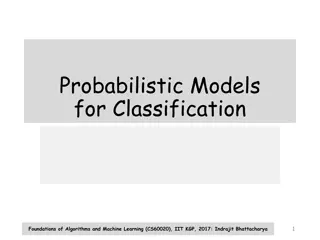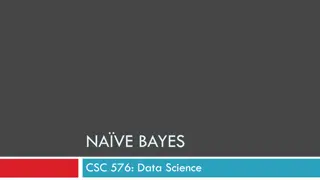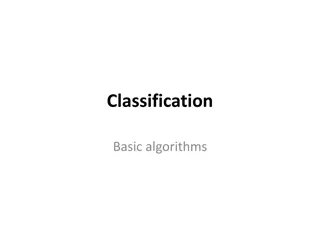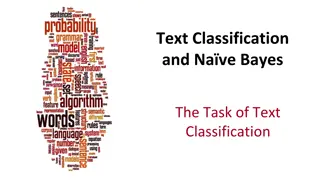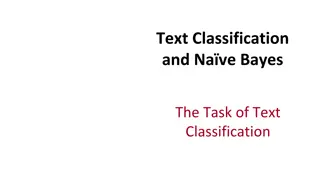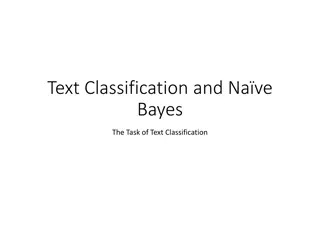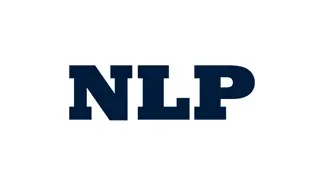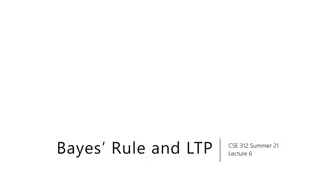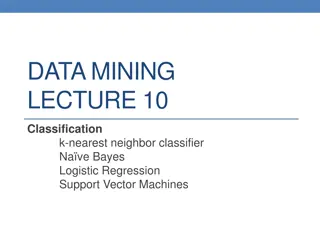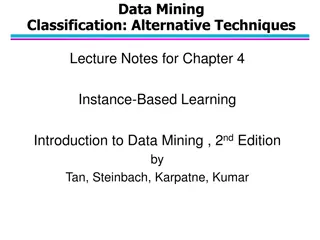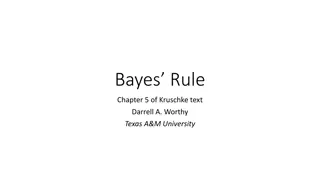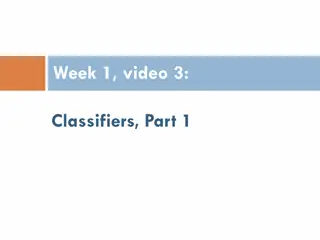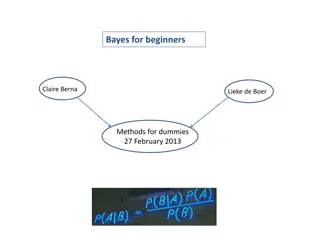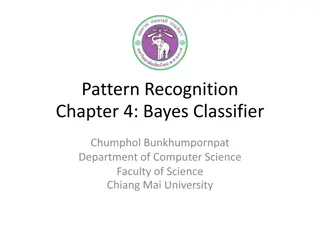Linear Classifiers and Naive Bayes Models in Text Classification
This informative content covers the concepts of linear classifiers and Naive Bayes models in text classification. It discusses obtaining parameter values, indexing in Bag-of-Words, different algorithms, feature representations, and parameter learning methods in detail.
Download Presentation

Please find below an Image/Link to download the presentation.
The content on the website is provided AS IS for your information and personal use only. It may not be sold, licensed, or shared on other websites without obtaining consent from the author.If you encounter any issues during the download, it is possible that the publisher has removed the file from their server.
You are allowed to download the files provided on this website for personal or commercial use, subject to the condition that they are used lawfully. All files are the property of their respective owners.
The content on the website is provided AS IS for your information and personal use only. It may not be sold, licensed, or shared on other websites without obtaining consent from the author.
E N D
Presentation Transcript
Mark Hasegawa-Johnson, 3/2018 CS440/ECE448 Lecture 15: Linear Classifiers Including Slides by Svetlana Lazebnik, 10/2016
Linear Classifiers Na ve Bayes/BoW classifiers Linear Classifiers in General Perceptron Differential Perceptron/Neural Net
Nave Bayes/Bag-of-Words Model parameters: feature likelihoods P(word | class) and priors P(class) How do we obtain the values of these parameters? Need training set of labeled samples from both classes # of occurrences of this word in docs from this class P(word | class) = total # of words in docs from this class This is the maximum likelihood (ML) estimate, or estimate that maximizes the likelihood of the training data: n D d = d 1 ( | ) P w class , , d i d i = 1 i d: index of training document, i: index of a word
Indexing in BoW: Types vs. Tokens Indexing the training dataset: TOKENS ? = document token index, 1 ? ? (there are n document tokens in the training dataset) ? = word token index, 1 ? ? (there are n word tokens in each document) Indexing the dictionary: TYPES ? = class type, 1 ? ? (there are a total of C different class types) ? = word type, 1 ? ? (there are a total of V words in the dictionary, i.e., V different word types)
Two Different BoW Algorithms One bit per document, per word type: ???= 1 if word w occurs anywhere in the i th document ??? = 0 otherwise One bit per word token, per word type: ??? = 1 if the j thword token is w ??? = 0 otherwise Example: who saw who with who? ??,"? ?"= 1 ??,"? ?"= {1,0,1,0,1}
Feature = One Bit Per Document Features: ???= 1 if word w occurs anywhere in the i th document Parameters: ??? ?(??? = 1|? = ?) Note this means that ? ??? = 0 ? = ? = 1 ??? Parameter Learning: Document (1 + # documents containing ?) ???= 1 + # documents containing ? + (1 + # documents NOT containing ?)
Feature = One Bit Per Word Token Features: ??? = 1 if the j thword token is word w Parameters: ??? ? ??? = 1 ? = ? = ?(?? = w |? = ?) Note this means that ? ??? = 0 ? = ? = ? ???? Parameter Learning: (1 + # tokens of ? in the training database) ?=1 (1 + # tokens of ? in the training database) Word Token ???= ?
Feature = One Bit Per Document Document Classification: C* = argmax P(C=c|document) = argmax P(C=c) P(Document|C=c) = argmax ?? ??? (1 ???) ? ?: ???=1 ?: ???=0 P(C=c) * prod_{words that occurred}P(word ooccus|C=c) * prod_{didn t occur} P(didn t occur|C=c)
Feature = One Bit Per Word Token Word Token Classification: C* = argmax P(C=c|document) = argmax P(C=c) P(Document|C=c) ? = argmax ?? ?=1 ???? ? P(C=c) prod_{words in the document} P(get that particular word | C=c)
Feature = One Bit Per Document Document Classification: ? ??? ??? ? = argmax ?? ?=1 (1 ???) 1 ??? ? ? ? = argmax ??+ ?????? ? ?=1 ? ??? ???= log , ??= log ?? (1 ???) 1 ??? ?=1
Feature = One Bit Per Word Token Word Token Classification: ? ?? ? = argmax ?? ?=1 ??? ? Where ??=number of times w occurred in the document!! So ? ? = argmax ??+ ?????? ? ?=1 ???= log???, ??= log??
Linear Classifiers Na ve Bayes/BoW classifiers Linear Classifiers in General Perceptron Differential Perceptron/Neural Net
Linear Classifiers in General ? The function ??+ ?=1 ???. That means that its contours are all straight lines. Here is an example of such a function, plotted as variations of color in a two- dimensional space ?1 by ?2: ?????? is an affine function of the features ?2 ?1
Linear Classifiers in General Consider the classifier ? ? ? = 1 if ??+ ?=1 ??????> 0 ? = 0 if ??+ ??????< 0 ?=1 This is called a linear classifier because the boundary between the two classes is a line. Here is an example of such a classifier, with its boundary plotted as a line in the two-dimensional space ?1 by ?2: ? = 0 ?2 ? = 1 ?1
Linear Classifiers in General ? = 3 ? = 1 ? = 2 Consider the classifier ? = 4 ? ? = 0 ? = 5 ? = 6 ? = argmax ??+ ?????? ? = 7 ? ?=1 This is called a multi-class linear classifier. The regions ? = 0, ? = 1, ? = 2etc. are called Voronoi regions. They are regions with piece-wise linear boundaries. Here is an example from Wikipedia of Voronoi regions plotted in the two-dimensional space ?1 by ?2: ?2 ?1
Linear Classifiers in General When the features are binary (?? {0,1}), many (but not all!) binary functions can be re-written as linear functions. For example, the function ? = (?1 ?2) can be re-written as C*=1 iff ?1+ ?2 0.5 > 0 ?2 Similarly, the function ? = (?1 ?2) can be re-written as C*=1 iff ?1+ ?2 1.5 > 0 ?2 ?1 ?1
Linear Classifiers in General Not all logical functions can be written as linear classifiers! Minsky and Papert wrote a book called Perceptrons in 1969. Although the book said many other things, the only thing most people remembered about the book was that: A linear classifier cannot learn an XOR function. Because of that statement, most people gave up working on neural networks from about 1969 to about 2006. Minsky and Papert also proved that a two-layer neural net can learn an XOR function. But most people didn t notice.
Linear Classifiers Classification: ? ? = argmax ??+ ?????? ? ?=1 Where ??? are the features (binary, integer, or real), ??? are the feature weights, and ?? is the offset
Linear Classifiers Na ve Bayes/BoW classifiers Linear Classifiers in General Perceptron Differential Perceptron/Neural Net
1909: Williams discovers that the giant squid has a giant neuron (axon 1mm thick) 1939: Young finds a giant synapse (fig. shown: Llin s, 1999, via Wikipedia). Hodgkin & Huxley put in voltage clamps. 1952: Hodgkin & Huxley publish an electrical current model for the generation of binary action potentials from real-valued inputs. The Giant Squid Axon
1959: Rosenblatt is granted a patent for the perceptron, an electrical circuit model of a neuron. Perceptron
Perceptron model: action potential = signum(affine function of the features) Perceptron Input C* = sgn( 1f1 + 2f2+ + VfV + ) = sgn(?? ?) Weights x1 w1 x2 Where ? = [?1, ,??,?]? and ? = [?1, ,??,1]? w2 Output: sgn(w x + b) x3 w3 . . . Can incorporate bias as component of the weight vector by always including a feature with value set to 1 wD xD
Perceptron Rosenblatt s big innovation: the perceptron learns from examples. Initialize weights randomly Cycle through training examples in multiple passes (epochs) For each training example: If classified correctly, do nothing If classified incorrectly, update weights
Perceptron For each training instance ? with label ? { 1,1}: Classify with current weights: ? = sgn(?? ?) Notice ? { 1,1} too. Update weights: if ? = ? then do nothing if ? ? then ? = ?+ y ? (eta) is a learning rate. More about that later.
Perceptron: Proof of Convergence If the data are linearly separable (if there exists a ? vector such that the true label is given by ? = sgn(?? ?)), then the perceptron algorithm is guarantee to converge, even with a constant learning rate, even =1. In fact, training a perceptron is often the fastest way to find out if the data are linearly separable. If ? converges, then the data are separable; if ? diverges toward infinity, then no. If the data are not linearly separable, then perceptron converges iff the learning rate decreases, e.g., =1/n for the n th training sample.
Perceptron: Proof of Convergence Suppose the data are linearly separable. For example, suppose red dots are the class y=1, and blue dots are the class y=-1: ?2 ?1
Perceptron: Proof of Convergence Instead of plotting ?, plot y ?. The red dots are unchanged; the blue dots are multiplied by -1. Since the original data were linearly separable, the new data are all in the same half of the feature space. ??2 ??1
Perceptron: Proof of Convergence Remember the perceptron training rule: if any example is misclassified, then we use it to update ?= ? + y ?. So eventually, ? becomes just a weighted average of y ?. and the perpendicular line, ?? ? = 0, is the classifier boundary. ? ??2 ??1
Perceptron: Proof of Convergence If the data are not linearly separable, then perceptron converges iff the learning rate decreases, e.g., =1/n for the n th training sample.
Implementation details Bias (add feature dimension with value fixed to 1) vs. no bias Initialization of weights: all zeros vs. random Learning rate decay function Number of epochs (passes through the training data) Order of cycling through training examples (random)
Multi-class perceptrons One-vs-others framework: Need to keep a weight vector wc for each class c Decision rule: c = argmaxcwc x Update rule: suppose example from class c gets misclassified as c Update for c: wc wc + x Update for c : wc wc x Update for all classes other than c and c : no change
Review: Multi-class perceptrons One-vs-others framework: Need to keep a weight vector wc for each class c Decision rule: c = argmaxcwc x Max Perceptrons w/ weights wc Inputs
Linear Classifiers Na ve Bayes/BoW classifiers Linear Classifiers in General Perceptron Differential Perceptron/Neural Net
Differential Perceptron Also known as a one-layer feedforward neural network, also known as logistic regression. Has been re-invented many times by many different people. Basic idea: replace the non-differentiable decision function ? = sgn(?? ?) with a differentiable decision function ? = tanh(?? ?)
Differential Perceptron Suppose we have n training vectors, ?1through ??. Each one has an associated label ?? 1,1 . Then we replace the true error, ? =1 4 ?=1 with a differentiable error ? =1 4 ?=1 ? ?? sgn(?? ??)2 ? ?? tanh(?? ??)2
Differential Perceptron And then the weights get updated according to ??= ?? ??? ???
Differentiable Multi-class perceptrons Same idea works for multi-class perceptrons. We replace the non- differentiable decision rule c = argmaxcwc x with the differentiable decision rule c = softmaxcwc x, where the softmax function is defined as Softmax: exp(wc x) C P(c|x)= exp(wk x) Softmax k=1 Perceptrons w/ weights wc Inputs
Summary You now know SEVEN!! different types of linear classifiers: One bit per document Na ve Bayes One bit per word token Na ve Bayes Linear classifier can implement some logical functions, like AND and OR, but not others, like XOR Perceptron Multi-class Perceptron Differentiable Perceptron Differentiable Multi-class perceptron
